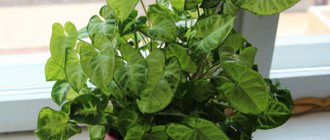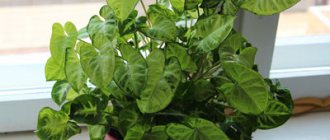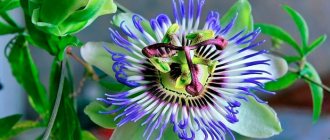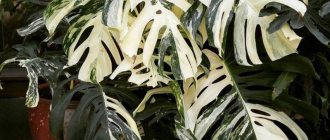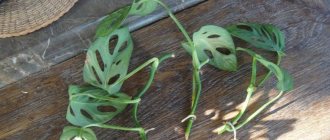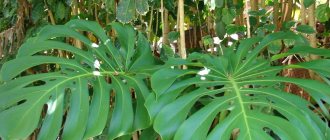Monstera is an evergreen exotic liana of the Araceae family. The epiphyte is native to the humid tropics of South America. The plant has large leaves with cuts or whole. At the top of the shoot there is a growth point.
The adventitious roots are quite long, thick and brittle. The flowers are inconspicuous, but the fruits are edible. The plant genus includes about 50 species and many varieties.
Features of Monstera
The name of the genus Monstera comes from the word “monstrum”, translated as “monster”, this is due to the large size of the plant and its frightening appearance. Representatives of this genus are evergreen vines and shrubs. Their thick shoots are climbing, and aerial roots are often present. Dark green long-petioled large leaf plates, leathery to the touch, decorate slits and holes of various shapes and sizes. The inflorescence is a thick cylindrical spadix, with sterile flowers at its base and bisexual flowers at the top.
Monstera is one of the most popular plants cultivated at home. It has been scientifically proven that indoor monstera is capable of ionizing the air in the room, which is a big plus when growing such a flower.
Pest Control
Even such a monster as Monstera is powerless against pests and can become infected with scale insects, thrips, spider mites and mealybugs. There is no need to be afraid of them, and the control measures are the same as for other plants. The leaves are first washed, preferably with soap and sprayed with an insecticide. It is worth choosing less toxic ones. A small plant can still be taken outside and sprayed, but a three-meter plant will have to be treated at home.
So, if you are not scared by all the difficulties of growing a monstera, feel free to start one. Still, a piece of the tropics at home will brighten up the anticipation of spring and vacation. And as a bonus, Monstera ionizes the air and is able to predict the weather. It turns out it's not such a monster.
Brief description of cultivation
- Bloom . Monstera is grown as an ornamental foliage plant. When grown at home, it blooms extremely rarely.
- Illumination . Needs a lot of bright but diffused light.
- Temperature regime . In the spring-autumn period - from 20 to 25 degrees, in winter - from 16 to 18 degrees. Make sure that the temperature in the room is not below 10 degrees.
- Watering . During the growing season, watering is carried out immediately after the top layer of soil mixture in the pot dries. With the onset of autumn, watering is gradually reduced, and in winter the soil mixture is moistened only after it has dried to 1/4 of the depth.
- Air humidity . It should be elevated. On hot days, you need to moisten the bush with a sprayer every day, but it is better to wipe the leaf blades with a damp sponge instead.
- Fertilizer . While the plant is young, it does not need to be fed. And adult specimens are fed regularly from the second half of spring until the last weeks of summer. To do this, organic and mineral fertilizers are used alternately.
- Support . It should be secured in the container during planting or transplanting the flower.
- Rest period . Not clearly expressed.
- Transplant . Until the age of three, the bush is replanted every year, from 3 to 5 years - the procedure is carried out once, and starting from the age of five, the plant is transplanted into a new pot once every 4-5 years. However, the top layer of soil mixture in the container must be changed to fresh one every year.
- Soil mixture . Young bushes are grown in a substrate consisting of turf and humus soil, as well as peat and sand (1: 2: 1: 1). For adult plants, a soil mixture consisting of deciduous, humus, turf and peat soil, as well as sand (1:1:3:1:1) is suitable.
- Reproduction . By cuttings, topping and seed method.
- Harmful insects . Scale insects, aphids and spider mites.
- Diseases . All problems that may arise when growing monstera are associated with improper care.
- Properties . The sap of the plant contains poison.
Monstera. Plant care | Recommendations of a biologist 7 COLORS
Planting, replanting, pruning, support
When planting a plant, you need to pay attention to the soil. It should be loose and neutral. There are several mixture options:
- take one part each of humus, peat and sand and add 2 parts of turf;
- mix one part each of bark, leaf soil, peat, moss and ½ part coarse sand;
- Add coconut fiber or perlite to the purchased soil for Saintpaulia.
Young vines should be replanted annually, as they grow very quickly. The pot should be 2-3 cm larger than the old one. It is better if its height and diameter are approximately equal. In a cramped container, the leaves may turn brown and thin, like papyrus.
The soil, drainage material and container must first be sterilized. Drainage should occupy approximately a fifth of the volume.
The plant must be replanted carefully, along with a lump of earth. Dry damaged roots must be trimmed. The vine is placed in the middle of the new container, covered with earth and lightly compacted.
Adult vines are replanted after two years. You will need fairly large flowerpots. It will depend on them how large the vine will be. The new container should be larger than the old one so that the root system feels comfortable.
Since the plant is quite large, it is better to transplant it together. Make the transplant step by step.
Replanting a very large monstera is a difficult task, so over time, only the top old layer of soil is changed with the addition of humus. If you don’t want such problems, you can start a mini plant.
A young monstera definitely needs support, as it curls. In addition, the vine will look more attractive. It is placed in a permanent place and sprayed. For an adult plant, you can make the support yourself. Sticks with coconut fiber are not a very suitable option, as it is difficult for the vine to gain a foothold. To make a support, you can take a piece of plastic tube, longer than the plant, and drill many slots in it. Next, place it in a pot and pour sand inside to the surface of the soil. Moss mixed with peat should be poured on top. The support is wrapped with damp moss, a mesh with cells on top and secured with fishing line. This design also requires regular spraying. Other options are possible.
The plant grows aerial roots, but they cannot be removed. If a vine climbs up a moss tube, the roots will grow into it themselves.
When an adult plant stops growing intensively, you can cut off its top for rejuvenation. The cut should be sprinkled with coal. This procedure promotes the growth of side shoots and crown formation.
Caring for Monstera at home
Illumination
Monstera needs a lot of bright light, but it must be diffused. In this regard, it is recommended to grow it on a western or eastern windowsill. If the flower is on the southern window, then it will need to be shaded from the sun, and on the northern one, it will not have enough light. If you provide the plant with a sufficient amount of diffused light, its foliage will be large and with spectacular holes or slits. With poor lighting, new leaf plates grow small, and aerial roots become thin and weak. It is recommended to move the flower to a new location only as a last resort.
Temperature
A flower grown indoors does not need any specific air temperature. One peculiarity was noticed in it - the warmer the room, the more intense the growth of the bush. From spring to autumn, the optimal air temperature for monstera is from 20 to 25 degrees. In winter, it is recommended to place the bush in a cooler place (from 16 to 18 degrees), but make sure that the room is not colder than 10 degrees. The greatest danger to it is represented by drafts in the autumn-winter period.
Watering
In spring and summer, watering should be plentiful; it should be done immediately after the top layer of the substrate has dried. To do this, use soft, well-settled water. With the onset of autumn, watering is gradually reduced, and in winter it is carried out only after 2 days have passed since the top layer of the soil mixture has dried. Remember that the plant reacts equally negatively to both the dryness of the earthen clod and the stagnation of water in the substrate. With regular waterlogging, rot may appear on the roots and spots on the foliage.
Spraying
Monstera reacts positively to systematic moistening from a sprayer; therefore, it is recommended to carry it out. To do this, use settled water at room temperature. The foliage must be systematically freed from dust using a dampened soft cloth.
Fertilizer
While the bush is young, it does not need to be fed. To ensure that the growth of an adult flower does not slow down, fertilizing is carried out from the second half of the spring until the end of summer once every 15 days; for this, organic matter and mineral fertilizers are used alternately.
Trimming
When growing at home, the bush should be supported with a lattice or stick, or the foliage should be pulled with a rope. After the growth of an old monstera slows down, it is recommended to cut off the top to stimulate the growth of side shoots.
Aerial roots
Each leaf blade grows aerial roots; under no circumstances should they be cut or torn off. It is recommended to lower these roots into the container in which the flower itself grows or into an additional pot filled with fertile soil mixture. Thanks to this, the nutrition of the entire flower improves. If these roots grow very slowly and do not reach the surface of the substrate in the pot, then it is recommended to tie them with moistened sphagnum moss or immerse them in a bottle filled with water. If desired, you can buy a plastic pipe, which should be wrapped in dry palm fiber, several holes are made in it, and a nutrient substrate is poured inside. The aerial roots of the flower must be directed into these holes. Droplets may form on the tops of leaf blades on a cloudy day before rain or in winter before a thaw.
Bloom
Growing in natural conditions, Monstera is distinguished by annual flowering. If the bush grows at home, then it will bloom very rarely. If the plant regularly receives a sufficient amount of nutrients, then after a couple of years it can produce a large inflorescence with bisexual flowers, which are part of a spadix with a cream sheath. In a ripe fruit, the sheath becomes woody and falls off. The length of the purple fruit is about 20 centimeters; in appearance it is similar to an ear of corn. They are formed by small and juicy fruits pressed against each other. They are very sweet and have a flavor that is both pineapple and strawberry.
Monstera transplant
During the first two years, the young plant is replanted every year, from 3 to 4 years - once every 2 years. When the bush is 5 years old, it is subjected to this procedure once every 3–4 years. However, the top layer of substrate in the pot must be replaced every year with fresh one. To transplant or plant a young plant, use a neutral or slightly acidic soil mixture (pH 5.5–6.0), which should consist of peat, turf and humus soil, as well as sand (1:1:2:1). An adult bush should grow in an earth mixture with a pH of 6.5–7.0, which consists of peat, humus, turf and leaf soil, as well as sand (1:1:3:1:1). You need to take a large pot, with a good drainage layer at the bottom.
Monstera Variegata (Alba) seedling, replanting and care at home.
Virulence
The juice of such a plant contains substances that cause inflammation of the mucous membrane and irritation of the skin. The juice of not fully ripened fruits can cause bleeding in the stomach and intestines, as well as inflammation of the oral mucosa.
Monstera - what soil is best for it?
Do you already have the Monstera of your dreams? Start by choosing a suitable substrate for it. When considering which soil is best for Monstera, consider the peat substrate, which must be permeable.
You can also use universal soil designed for potted plants. However, remember the drainage layer. You can add perlite to the soil. This material loosens and aerates the base.
Reproduction methods
Growing from seeds
The sown monstera seeds are placed in a warm and well-lit place. The first seedlings should appear within 30 days. The first leaf blades are juvenile and have no slits. The first adult foliage appears at 5–8 months. After 2 years, the bush will have no more than four adult leaf blades and up to 5 juvenile ones. The seedlings are first planted in individual pots, and then they are replanted every year.
Cuttings
Cuttings are carried out throughout spring until early summer. Monstera can be propagated by stem or apical cuttings, as well as by lateral shoots. A cutting is a piece of stem with 1–2 leaf blades. The cut areas are treated with charcoal powder. For rooting, the cuttings are planted in a separate pot, and the top is covered with glass. At the bottom you need to make a drainage layer from pieces of brick, cover it with a two-centimeter layer of peat or humus soil, and then pour 20–30 mm of sand. Watering is carried out regularly in the morning and evening, and the air temperature should be 20–25 degrees. After the cuttings grow roots, they are planted in an intermediate pot. After 3 or 4 years, the overgrown bush is transplanted into a tub or larger pot. In order for the cutting to take root faster, you need to choose one that has aerial roots.
Monstera. Rooting monstera cuttings.
Reproduction by apex
Old bushes lose their decorative value because their lower leaf plates fly off. In this regard, you can wrap the 2 upper aerial roots with moistened moss or twine and fix them on the trunk of the flower. After the roots grow, cut off part of the trunk with 1-2 leaf blades, and treat the cut area with charcoal powder. Plant the cutting in a pot, while covering the roots and the cut area with substrate. The old bush should also send out side shoots, and it will become more lush.
Monstera - it will not be difficult for you to propagate the plant
Vegetative propagation of monstera is a task that is easy to cope with. All you have to do is use the tip seedling. It must have at least two leaves, as well as a visible aerial root. Spring is the best time to plant a seedling.
Cut off the shoots and place in water. Rooting time depends on the conditions you create for the plant. It’s good if you place the seedling in a place where the temperature is about 25 degrees. Rooting will take about a few weeks.
- Monstera is easy to propagate thanks to apical cuttings that take root in water. Provide the seedling with a temperature of 25 degrees.
Monstera may bloom, although this is rare. The flower is shaped like a flask surrounded by a large white sheath. After flowering, aromatic conical-shaped fruits are formed (ripe fruits are edible, taste like pineapple, but it is better not to eat them, as they can irritate the mucous membranes). Fruit juice is used in Mexico to make drinks, ice cream and sparkling wine.
Possible problems
If you do not care for the monstera correctly or do not provide it with optimal conditions for growth, then problems may arise with it.
- Leaves fall . If the lighting is too poor, then the plant begins to shed its leaves, and its growth also stops.
- Spots on foliage . Brown spots may appear on the underside of the leaf blades if spider mites have settled on the bush.
- Yellowing of leaves . The foliage turns yellow if the monstera feels a lack of nutrients. Also, the foliage may turn yellow, and rot may also appear on it due to regular stagnation of liquid in the substrate.
- The foliage turns brown . The leaf blades turn brown and become papery if the air humidity level is too low or when the flower is very crowded in the pot.
- The color of young leaf blades is pale . If the lighting is too intense, then faded leaves appear on the bush, and yellow spots may also form on their surface.
- The bush stretches out . If the monstera does not have enough light, then its shoots become elongated, the stem twists, and new leaf plates grow faded and small.
- Whole foliage . There may be no slits on young leaf blades due to the fact that the flower feels a lack of light or nutrients.
- The foliage dries up and flies away . If the leaf blade turns brown and dries out before falling, this means that the room is very hot. The foliage also falls off as it ages, but in this case it does not turn brown.
- Harmful insects . Most often, aphids, scale insects and spider mites settle on the monstera.
Reality
In fact, the indoor plant secretes phytoncides that destroy pathogenic microorganisms . Today there are many varieties of monstera: compact, variegated, with patterns on the leaves. Most often, gardeners prefer the following types:
- Monstera deliciosa . A classic vine with perforated dark green leaves. A few years after planting, it may begin to bear fruit.
- Monstera oblique . The plant is small in size, unlike other species, has leaves with oblong holes. They may have veins of different shades, which makes the appearance of the vine even more original.
- Monstera is doubtful . The capricious indoor flower has variegated leaves, which is why it is often confused with scindapsus.
Is it possible to keep an exotic vine at home? Monstera? Of course yes. But you should know that it develops quickly, requires large areas and high humidity. Therefore, the plant is suitable for offices and hallways of large organizations.
Carefully! There is no need to place the potty in narrow corridors. The leaves are easily injured by touching; Due to drafts, they may turn yellow and fall off.
Types of monstera with photos and names
Monstera adansonii
This species is found naturally in the tropical zone from Costa Rica to Brazil. This vine can reach a height of about 8 meters. Thin ovoid leaf plates are 20–40 centimeters wide and 25–55 centimeters long. There are many holes on the entire surface of the plate. When grown at home, flowering of this species is extremely rare. During flowering, a short peduncle appears, on which a yellowish ear is formed, its length is 8–12 centimeters and its width is 1.5–2 centimeters.
Monstera deliciosa borsigiana
Under natural conditions, the species is often found in Mexico. Its stems are thinner than those of Monstera deliciosa, and the leaf blades are smaller (up to 0.3 m in diameter). The species grows well both at home and in other premises.
Monstera deliciosa
This climbing vine comes from the humid and montane forests of the tropics of Central America. It can grow at an altitude of up to 1 kilometer above sea level. Young leaf blades have a heart-shaped shape and a solid edge. As the foliage grows, it increases in size (up to 0.6 m in diameter), becomes leathery to the touch, heavily dissected and with holes. Covered with a white sheath, the cob reaches about 25 centimeters in length and up to 20 centimeters in width. The pulp of the emerging fruits can be eaten; it has a pineapple taste and aroma. The height of such a plant in a greenhouse can reach 12 meters, and at home - about 3 meters. If an adult flower is provided with proper care, flowers will appear annually. There is a variety of variegata: the foliage is variegated white, the plant itself is characterized by slower growth and higher care requirements.
Monstera obliqua
Either Monstera expilata or Monstera falcifolia. This climbing vine comes from the tropics of Brazil and Guiana, and is found in humid forests. The whole elliptical or lanceolate leaf plates are unequal at the base, their width is about 6 centimeters, and their length is up to 20 centimeters. The length of the petiole is no more than 13 centimeters. During flowering, an eight-centimeter peduncle grows, on which a few-flowered spadix about 40 mm long is formed.
Monstera pertusa
In nature, this climbing vine is found in the tropical rainforests of America. The shape of the foliage is ovoid, it looks like an elongated egg, its length is about 0.9 meters, and its width is up to 0.25 m. The holes on the plate are unevenly spaced, and the plate itself is unequal (expands more towards the bottom of the leaf). The length of the cob is 10 cm, it is covered with a white sheath, reaching a length of 20 cm.
Monstera - My favorite. Home care
What is the difference between Monstera and Philodendron?
Initially, the liana belonged to the Philodendron genus and was named Philodendron opacum. But in the 70s of the last century, biologists finally identified Tropicana as a separate genus. Most of the distinctive features can only be seen by a specialist. It's basically the structural anatomy of the individual parts.
External differences:
- the flower is white (philodendron is red);
- large leaf – up to 30 cm in diameter and up to 50 cm in length;
- lack of milky juice;
- the presence of cuts along the edge of the sheet plate;
- need for support;
- the presence of well-developed aerial roots.
Watering
Watering must be done correctly.
- Since Monstera deliciosa likes to be in conditions of high humidity, regardless of the time of year, you need to regularly wipe its leaves with a damp cloth. It is worth noting that only mature leaves can be wiped; young leaves cannot be touched.
- In the warm season, you do not need to water too often or abundantly. Watering should be moderate and the soil should always be allowed to dry out a little. As a rule, exotic plants need regular watering from April to September, then the number of waterings should be reduced.
- In winter, the number of waterings should be reduced even more, and the soil should be kept dry.
- Leaves should be sprayed with water at any time of the year. Do not forget to spray the leaves, especially in winter, as indoor air humidity decreases due to heating devices.
- Feeding should be done 2 times a month. Alternate organic and mineral fertilizers. In the winter season, you can do without feeding.
- Many owners of Monstera deliciosa are faced with the problem of spots on the leaves. There is no need to be afraid of this: the stains indicate that the air in the room is too dry. If you correct the situation and create comfortable conditions, the exotic will be healthy again. To restore the color and health of the leaves, it is enough to regularly spray them with water.
- If the leaves begin to turn yellow, this indicates that you are watering it too often and abundantly. Reduce the amount of watering and the plant will return to its normal state.
You can learn more about Monstera deliciosa in the following video.
Classification according to V. M. Baranova
According to V. Baranova’s classification, eight stable characteristics have been identified. Based on them, the genus is divided into 11 sections:
- Lilium - horizontal arrangement of flowers, their color is white;
- Eurolirium - drooping flowers, leaves red, green or white;
- Martagon - flowers grow to the sides or upwards;
- Pseudomartagon - drooping flowers, leaves varied in shape and color;
- Archeltrion - direction of flowers to the sides or upwards;
- Regalia - horizontal arrangement of flowers, snow-white perianth;
- Sinomartagon - drooping flowers;
- Sinolirium - upward direction of flowers;
- Pseudolirium - flowers look up, leaves are arranged alternately;
- Nepalensia - flowers directed upwards, perianth in the form of a bell.
Origin
Monstera is a plant of the Araceae family, famous primarily for its large leaves. The name of the plant translates as “bizarre” (another version of “monster”), and the tropical forests of Central America are called its homeland. In nature, the liana is also found in Asia, South America, in the tropics of Mexico, Costa Rica, and Panama. In Australia it is grown for its edible cobs.
There are many conflicting claims associated with it, one of which concerns its toxicity. This issue will be covered in more detail in a separate chapter of this article. Now let’s look at other features of growing vines at home. It has large leaves, and therefore actively releases oxygen and evaporates moisture. All this allows you to maintain an optimal indoor microclimate. The huge leaves of the vine absorb electromagnetic radiation and formaldehyde fumes.
Monstera can often be seen in offices, lecture halls, and libraries. And this is due not only to the fact that a large plant looks attractive in large rooms, but also to the fact that it has a positive effect on the nervous system - it calms, allows you to concentrate, and harmonizes thoughts. In addition, the vine has strengthening properties.
Interesting facts about Monstera deliciosa
There are many myths about the plant. The most common rumors are that monstera is poisonous, brings trouble to the house and takes away energy from the residents. There is no scientific confirmation of this, so you can safely start a vine in your apartment.
What interesting things are known about Monstera Deliciosa:
- from Latin the name “monstrum” is translated as “monster”. It occurred thanks to creeping stems, the diameter of which reaches 20 cm and has long aerial roots;
- according to another version from Latin, the name is translated as “bizarre”, “amazing”, which fully corresponds to its appearance;
- Princess of Brazil Isabella of Braganza, daughter of Emperor Pedro II, started the tradition of eating monstera fruits for dessert; it was her favorite delicacy;
- before the rain, drops of sticky juice appear on the leaves, so the flower is a kind of barometer;
- Esotericists believe that aerial roots take away energy from those around them, but they are necessary solely to obtain additional moisture from the air, since the plant’s homeland is the tropics;
- residents of Southeast Asia are confident that monstera is a source of health and well-being;
- in Thailand, it is customary to place a pot of vines near sick people;
- In Laos, Monstera deliciosa is used as a talisman and placed on the doorstep of the house.
Note! There are also several versions about the origin of the name of the flower, which concern not only its appearance. One of the legends says that after the discovery of South America, killer plants were discovered in the jungle that attacked people and animals
They said that after the battle with the vines, all that remained of the body were skeletons hanging from the trunk. In fact, travelers confused the murders with aerial roots sprouted into the already deceased body of a person who once died in the jungle.
Liana in the wild
Where to place the raphidophora
Raphidophora loves bright, diffused light, so it is best to place it next to a western or eastern window away from direct sunlight. In the shade, its leaves will begin to shrink, and in the bright sun they will become covered with yellow spots.
Like all tropical plants, Raphidophora is thermophilic. The ideal temperature for her is 18–28 degrees, but she will tolerate even more intense heat. It is much more important to maintain high humidity in caring for raphidophora. To do this, the plant should be sprayed with water daily, preventing it from accumulating on the leaves, or install a humidifier next to it. Another way to maintain optimal humidity is to place the raffidophora next to other tropical plants, together they will form an ideal microclimate for themselves. You can also wipe the leaves of the raphidophora with a damp sponge, and use a special polish to make them shine.
Rafidophora does not tolerate drafts, temperature changes and does not tolerate constant changes of location.
Remember that raphidophora is a climbing plant, it definitely needs the ability to stretch upward, so use a trellis and other structures that it can cling to. They must be strong enough to support all the leaves as the vine grows.
Raphidophora leaves can be toxic, so keep it away from children and animals.
Read on topic:How to grow peperomia

